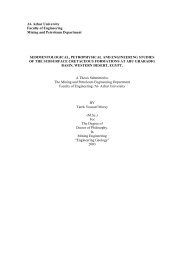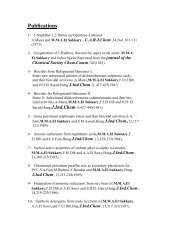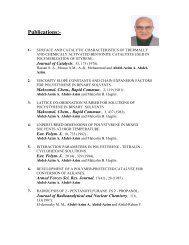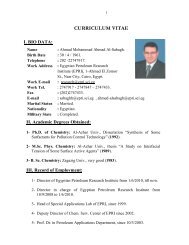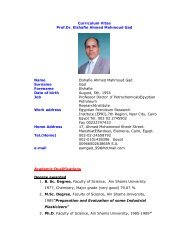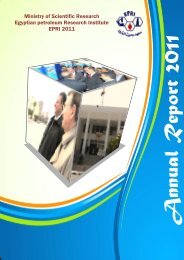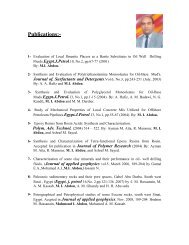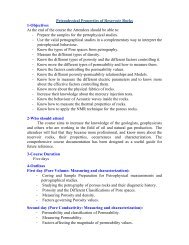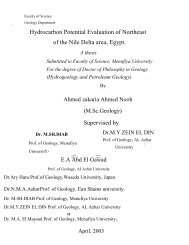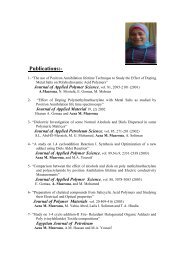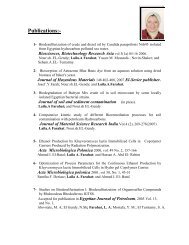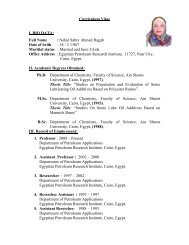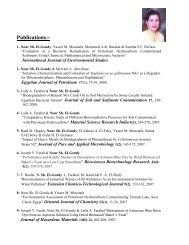Download - Egyptian Petroleum Research Institute
Download - Egyptian Petroleum Research Institute
Download - Egyptian Petroleum Research Institute
You also want an ePaper? Increase the reach of your titles
YUMPU automatically turns print PDFs into web optimized ePapers that Google loves.
3- PETROCHEMICALS<br />
Edited by: Vivek Patel<br />
Published by: InTech,<br />
Croatia, March 2012.<br />
ISBN: 978-953-51-0411-7<br />
www.intechopen.com<br />
Chapter 12 – New Trends<br />
in Hydroprocessing Spent<br />
Catalysts Utilization<br />
249<br />
Hoda S. Ahmed and<br />
Mohammed F. Menoufy<br />
Summary of the chapter:<br />
The objective of this<br />
chapter is to give academics, research scientists, research<br />
scholars, science and engineering students and industry<br />
professionals an overview of the different utilization technologies<br />
for hydrotreating spent catalysts.<br />
Hydrotreating catalysts consist of critical metals such as Mo, Co,<br />
and Ni, as active metals and are generally supported by alumina<br />
or silica alumina and are usually used in hydrotreating<br />
petroleums. These catalysts deactivate with time, and partial or<br />
complete regeneration can be carried out depending on the<br />
severity of the processes due to carbon or sulfides deposition. In<br />
the long term, the regeneration of these catalysts will become<br />
impossible due to irreversible deactivation, and spent catalysts<br />
would discard as solid wastes. The volume of these solid wastes<br />
has increased significantly worldwide and in <strong>Egyptian</strong> petroleum<br />
refining industries due to a steady increase in upgrading of<br />
feedstock or distillates to meet the environmental regulations for<br />
low sulfur fuels.<br />
Several alternative methods such as disposal in landfills,<br />
reclamation of metals, regeneration/ rejuvenation and reuse, and<br />
utilization as raw materials to produce other useful products are<br />
available to the refiners to deal with the spent catalyst problems.<br />
The choice between these options depends on technical<br />
feasibility and economic consideration.<br />
In recent years, increasing emphasis has been placed on the<br />
development of processes for recycling and recovering of the<br />
waste catalyst metals, as much as possible. In literature there are<br />
many applied researches for spent metals recovery, particularly<br />
for catalyst that contain high concentrations of valuable metals<br />
(Mo, Ni, V and Al2O3) However, fluctuations in the market prices<br />
of the recovered metals and their purity, together with the high<br />
costs of shipping significantly influence the economics of the<br />
metal reclamation process that making it less attractive.<br />
and metal contaminants. Therefore, many efforts were subjected<br />
to replace the conventional regeneration procedures in order to<br />
reactivate and rejuvenate the spent catalysts. The new<br />
procedures are conducted to remove contaminant metals<br />
selectively by chemical treatments without significantly affecting<br />
the chemical and physical characteristics of the original catalyst<br />
In experimental works, carried out by the authors of this<br />
chapter in EPRI (1), concerning spent catalysts, were succeeded<br />
in rejuvenating the spent catalyst Mo-Ni/Al2O3 using for rerefining<br />
of waste lube oil, and applied in Alexandria <strong>Petroleum</strong><br />
Company. Our data revealed that the treated spent catalyst could<br />
be restored nearly its fresh HDS activity levels by application of<br />
oxalic acid leaching technique in addition to H2O2 as an oxidizing<br />
agent. The most effective leaching agent was 4% oxidized oxalic<br />
acid, and the extent of metals recovered was dependent on acid<br />
concentrations or the specific reuse of the spent catalyst. The<br />
rejuvenation process promotes the formation of a<br />
hydroprocessing catalyst due to its improvements in surface area<br />
and average pore diameter (i.e. 87% and 63% of the fresh<br />
catalyst characteristics, respectively). These improvements<br />
caused recovery in the HDS activity of the treated catalyst in the<br />
ranges of 81–96 wt %<br />
Other utilization of spent catalysts, experimental data reveal<br />
that the treatment processes succeeded for extracting nickel,<br />
molybdenum and aluminum oxides in quantities of 25, 30, 45<br />
wt% as raw materials using in the production of other valuable<br />
industrial products. These results are attractive options from<br />
environmental and economical points of view.<br />
References of authors’ data:<br />
1- E. Z. Hegazy., M.Sc. Thesis, Tanta University, Tanta (2003)<br />
2- M. F. Menoufy, H. S. Ahmed, in Proc. of the OAPEC Seminar on<br />
Energy Conservation and Environmental Protection in<br />
<strong>Petroleum</strong> Industries, Cairo (2004).<br />
3- M. F. Menoufy, H. S. Ahmed, .Energy Sources, Part A, 30:1213–<br />
1222, (2008)<br />
4- H S. Ahmed, M.F. Menoufy., Chem. Eng Technol., 32, No. 6,<br />
873–880, (2009).<br />
Many literature review revealed that reactivation of spent<br />
catalysts technology did not reach to well developments.<br />
Spent catalysts lose their activities, and deactivated by pore<br />
blockage and fouling of the active surface with deposition of coke<br />
EPRI Annual Report 2012 24



